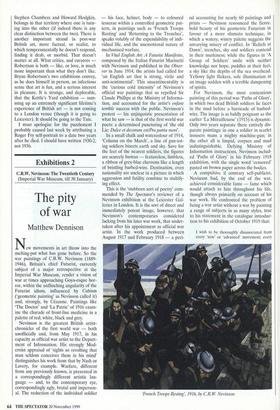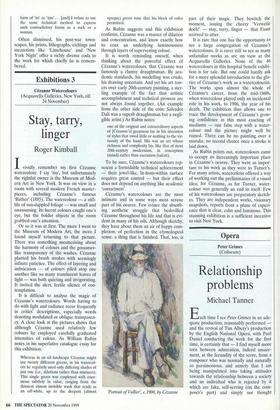Exhibitions 2
C.R.W. Nevinson: The Twentieth Century (Imperial War Museum, till 30 January)
The pity of war
Matthew Dennison
New movements in art throw into the melting-pot what has gone before. So the war paintings of C.R.W. Nevinson (1889- 1946), Britain's chief Futurist, currently subject of a major retrospective at the Imperial War Museum, render a vision of war at times approaching Goya-esque hor- ror, within the unflinching angularity of the Futurist idiom, influenced by Cubism (`geometric painting' as Nevinson called it) and, strongly, by C6zanne. Paintings like 'The Doctor' and 'La Patrie' of 1916 exam- ine the charade of front-line medicine in a palette of red, white, black and grey.
Nevinson is the greatest British artist- chronicler of the first world war — both unofficially and, from May 1917, in his capacity as official war artist to the Depart- ment of Information. His strongly Mod- ernist appraisal of 'sights so revolting that man seldom conceives them in his mind' distinguishes his work from that by Nash or Lavery, for example. Warfare, different from any previously known, is presented in a correspondingly different artistic lan- guage — and, to the contemporary eye, correspondingly ugly, brutal and imperson- al. The reduction of the individual soldier — his face, helmet, body — to coloured tesserae within a controlled geometric pat- tern, in paintings such as 'French Troops Resting' and 'Returning to the Trenches', speaks volubly of the expendability of indi- vidual life, and the unemotional nature of mechanised warfare.
In Vital English Art: A Futurist Manifesto, composed by the Italian Futurist Marinetti with Nevinson and published in the Obser- ver in June 1914, the artists had called for 'an English art that is strong, virile and anti-sentimental'. This unsentimentality is the 'curious cold intensity' of Nevinson's official war paintings that so repelled Sir Claude Phillips at the Ministry of Informa- tion, and accounted for the artist's enfant terrible success with the public. Nevinson's protest — his unjingoistic presentation of what he saw — is that of the first world war poets: a determined puncturing of 'the old Lie: Duke et decorum est/Pro patria mori'.
In a small chalk and watercolour of 1914, 'Column on the March', a line of gun-tot- ing soldiers bisects earth and sky. Save for the feet of the nearest soldiers, the figures are scarcely human — featureless, limbless, a ribbon of grey-blue chevrons like a length of bristling barbed-wire. Destination, even nationality are unclear in a picture in which aggression and futility combine to stultify- ing effect.
This is the 'stubborn sort of poetry' com- mended by The Spectator's reviewer of a Nevinson exhibition at the Leicester Gal- leries in London. It is the sort of direct and immediately potent image, however, that Nevinson's contemporaries considered lacking from his later war work, that under- taken after his appointment as official war artist. In the work produced between August 1917 and February 1918 — a peri-
od accounting for nearly 60 paintings and prints — Nevinson renounced the fierce, bold beauty of his geometric Futurism in favour of a more sfumato technique, in which a watery, wintry palette suggests the unvarying misery of conflict. In 'Reliefs at Dawn', trenches, sky and soldiers contend in their murkiness; while the figures in 'A Group of Soldiers' smile with neither knowledge nor hope, puddles at their feet, a sky like the depths of the sea overhead. Yellowy light flickers, sole illumination in an image sodden with a terrible dampening of spirits.
For Nevinson, the most contentious painting of this period was 'Paths of Glory', in which two dead British soldiers lie faces in the mud before a barricade of barbed- wire. The image is as baldly poignant as the earlier `La Mitrailleuese' (1915) is dynamic. Only two years separate these entirely dis- parate paintings: in one a soldier in scarlet trousers mans a mighty machine-gun; in the other all is limpid, corpses and mud indistinguishable. Defying Ministry of Information instructions, Nevinson includ- ed 'Paths of Glory' in his February 1918 exhibition, with the single word 'censored' pasted on brown paper across the bodies.
A compulsive if contrary self-publicist, Nevinson had, by the end of the war, achieved considerable fame — fame which would attach to him throughout his life, though always primarily on account of his war work. He confronted the problem of being a war artist without a war by painting a range of subjects in as many styles, true to his statement in the catalogue introduc- tion to his exhibition of October 1919 that:
I wish to be thoroughly disassociated from every 'new' or 'advanced' movement; every
'French Troops Resting' 1916, by C.R.W. Nevinson
form of `ist' or 'ism' [and] I refuse to use the same technical method to express such contradictory forms as a rock or a woman.
Often dismissed, his post-war town- scopes, his prints, lithographs, etchings and mezzotints like `Limehouse' and 'New York Night' offer a richly diverse coda to the work for which chiefly he is remem- bered,



























































































 Previous page
Previous page